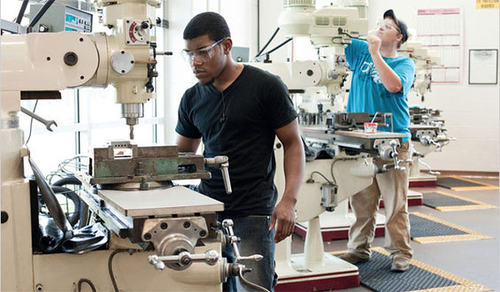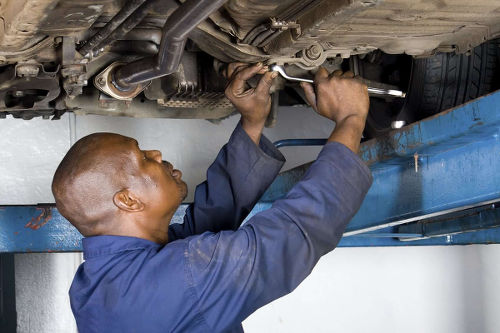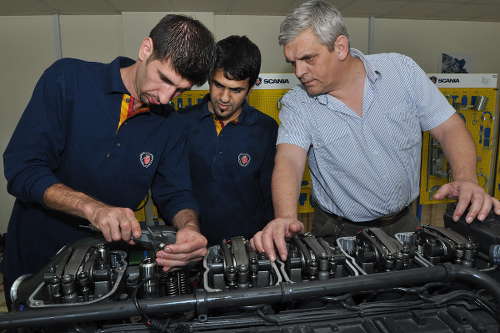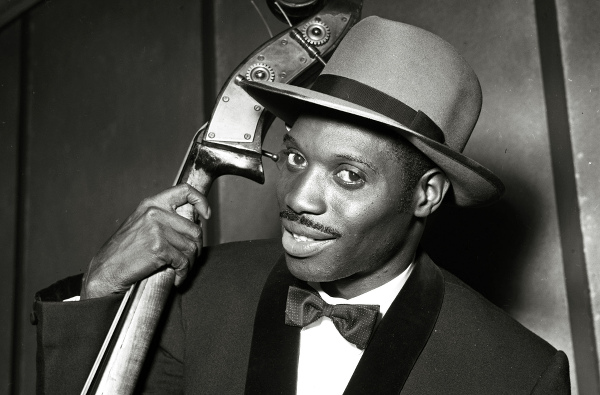“The idea that bright students use their brains rather than their hands continues to haunt the Education System; it has a demonstrably negative effect on the Tech-Voc subjects.
“[…] The result of this prejudice is that we have technicians but not technologists, that we produce students who can repair shoes but who do not know how to design them.
“It also means that we deny the ‘bright’ students the skills to be self-employed entrepreneurs and that our engineers largely have to acquire their Tech-Voc skills in university.”
The following guest column was submitted by former Trinity College (Moka) principal Michael Clarke, who also worked in Curriculum Development at the Ministry of Education and was Chief Examiner for CSEC Geography until 2016:

Allied to my own personal, first-hand experience, recent statements on Education from local sources and sources across the Caribbean and in the USA convince me that our education system needs to be upgraded.
The statements include the Caribbean Examination Council (CXC) newsletter outlining the “wallet of qualifications” candidates can earn in the various examinations, a statement by a Caribbean minister to the effect that the CXC’s CVQ is designed to cater for those who are “vocationally inclined” and the view of Trinidad and Tobago’s attitude to Tech-Voc students expressed by a Trinbagonian former Tech-Voc student who is now a plumber in the USA.
Finally, there is the comment made by Anthony Garcia, the current T&T Education Minister, in reference to the number of candidates who got “full certificates” in the 2018 Caribbean Secondary Education Certificate (CSEC) examinations.
I will focus on three inputs in the system in Trinidad and Tobago: the policy and attitude to Tech-Voc Education, assessment of boys in co-ed schools and the standard allotment of five years made available to students in secondary schools.
Attention to these three will, I think, go a long way in helping students to achieve their full potential as well as becoming disciplined, academically balanced citizens, able to contribute to the development of the country.
We in T&T need to recognise that, as happens with computer operating systems, there comes a time when attempting to patch the education system is no longer a viable option and a new system is needed. In order to get the best for and from the students, we have to examine the inputs and processes and change them and the related infrastructure.

(Courtesy Sean Morrison/Wired868)
We also need to remember that it is in the nature of systems to resist change and that systems always seek to maintain themselves.
The original inputs in the T&T Education System were made based on the philosophy behind educating children which was then held. The curriculum, the number of secondary school places and Technical-Vocational training options reflected a belief that just about 10% of the students could benefit from the secondary education on offer in grammar schools and a mere 4% from what university provided.
Tech-Voc training was offered in post-primary centres. This was the status quo until 1960.
The public secondary schools took the top 10% of the primary school students but none had a Tech-Voc programme open to all students in Form 5. Where available, the Tech-Voc subjects were reserved for the “weaker” students. Guiding that curriculum was the belief that a student who was not good with his brains would be good with his hands and that those who were good with their brains were best served by taking academic courses.
Yet the technical institutes required applicants to have O- and A-level passes in academic subjects related to the courses they offered!
Despite successful professionals, businessmen and women and many contractors graduating from technical and vocational institutes, the academic subjects were and still are seen by many in the society as the “better” options on which to set your sights. Even among successful parents, few seek to form a family business in their Tech-Voc area by encouraging their children to follow them as a first option.

When new secondary schools were opened in 1961, the first major patch was made to the system, with secondary education being offered to 20% of the students. Tech-Voc subjects were included in the curriculum because the catchment now included a wider ability range.
Parents generally objected to their children being offered Tech-Voc subjects and the curriculum of those schools had to be modified in favour of academic and aesthetic subjects. Parents—and students!—continued to see Tech-Voc subjects as courses for dunces.
This view persisted even after the completion of another patch in 1974, when the so-called comprehensive schools came into being. The policy document stated clearly that these new institutions were not true comprehensive schools but two schools on the same compound, one academic and the other Tech-Voc.
The Tech-Voc programme continued to be for the “weaker” students, a designation arrived at on the basis of performance during the three years spent in the Junior Secondary Schools.
Today, things have changed and all students now qualify to attend secondary school. However, the idea that bright students use their brains rather than their hands continues to haunt the Education System; it has a demonstrably negative effect on the Tech-Voc subjects.
Based on their performance in the SEA examination, we stream the top students (about 10%) into the schools with sixth forms, then the next 10% into the older five-year schools and the remaining 80% into the new schools.

(Copyright BBC.co.uk)
As a rule, the older schools with sixth forms do not offer Tech-Voc subjects, these continue to be offered to the “weaker” students. The result of this prejudice is that we have technicians but not technologists, that we produce students who can repair shoes but who do not know how to design them.
It also means that we deny the “bright” students the skills to be self-employed entrepreneurs and that our engineers largely have to acquire their Tech-Voc skills in university.
Tech-Voc education is expensive, it is true. But what we need is to have ALL schools offering Tech-Voc subjects in an integrated curriculum. To achieve this, the curriculum of the grammar schools, for example, BAHS, CIC, QRC and SAGHS, will need to be modified.
But there is an important question which has to be answered before we proceed with the necessary modification. At what age, we must ask ourselves, is it best to determine the Tech-Voc specialty and offer the required education?
If, as many countries do, we turn our eyes to the example of Sweden, we see that there Tech-Voc is first offered at age 16. That is more or less the age at which our students write the CXC CSEC exams before some go on to do their Caribbean Advanced Proficiency Examination (CAPE) courses.
Here in T&T, we try to identify the Tech-Voc aptitudes among those we think are “vocationally inclined” at 14+. Our exam results seem to say that that is not the proper age.

(Copyright Scania.com)
As the NAR’s Minister of Education, the late Clive Pantin planned to get help from Germany and—as is done in that country—offer Tech-Voc education after a common secondary foundation programme. The system resisted that change.
What may be needed in all secondary schools is an introduction to Technology Education in the lower and middle school and then a more comprehensive Tech-Voc programme at sixth form level for those who are interested.
Is there any real reason, after all, why what obtains for CAPE subjects should not also obtain for Tech-Voc?
In the late 1990s and the early years of this century, the Curriculum Development Division at the Ministry of Education—including the Secondary Education Modernisation Programme (SEMP)—made attempts to introduce Technology Education in all schools. Once more, the System resisted the change.
And won.
In a recent TV interview done in the USA, Judaline Cassidy, who had attended a trade school in Trinidad and is now a successful Trinbagonian plumber in New York, said the current system in T&T does “a disservice to the country as it images tradespeople as baffling idiots and the country is falling apart because no one is there to take the trades jobs.”
“The trades,” she added, “need to be exalted.”
Editor’s Note: Click HERE to read Part Two of Michael Clarke’s series on ‘The marginalisation of Tech-Voc Education’.
Want to share your thoughts with Wired868? Email us at editor@wired868.com.
Please keep your letter between 300 to 600 words and be sure to read it over first for typos and punctuation.
We don’t publish anonymously unless there is a good reason, such as an obvious threat of harassment or job loss.
 Wired868 Wired868 for smart sport news and opinion
Wired868 Wired868 for smart sport news and opinion







I appreciate this articulation by Mr. Clarke. I would like to humbly advance that the first hiccup I daresay is offering Technology Education as subject and not as approach to delivery across the lower secondary school curriculum that primarily employs problem solving. MOE’s goal and concomitant outcome of innovative highly skilled persons would better be realized.
Maybe this may go towards improving the status and approach to teaching of the tech voc subjects in the upper level of secondary school.
Everyone has a role to play and tech voc is just as important as any of the traditional subjects based on “academics” – ignorant people need to stop classifying tech voc as some kind of second rate career. A systems approach in all things is the key to success.
I can draw from my experience within the ‘prestige school’ system nearly three decades ago to reinforce the author’s points. The only tech-Vic subject thatbwecwrre ever exposed to at secondary level was Technical Drawing. It was taught to everyone for one full academic year, albeit as a lower form subject when students were doing as many as 13 or 14 subjects for the year.
I distinctly remember there being negative connotations to TD, with it being perceived as a subject for the inferior students both in and out if the school. In fact, the guys toting T-squares (because back then it wasn’t even on the agenda at girls schools – Home Economics, Office Procedures and Integrated Science were their portion) were those going to Junior/Senior Secondary or Senior Comprehensive schools. And those students there weren’t ‘bright’; that’s why they passed for that school!
To further reinforce the negative stereotype in my school, TD was offered as a full-on CXC subject to what was considered the academically weakest class of students in Form 4-5.
However, there is a delicious irony in the matter. When my school celebrated its excellence at A levels and how many would go on to do Engineering at tertiary level, most of that crop wee at a disadvantage when it came to classes at university involving engineering drawing, having last done that five years prior. (AutoCAD and its ilk were in their infancy then, requiring powerful and powerfully expensive computers of the era to run them.)
The solution? Once you were attempting Maths and Physics at A level, in the first year of sixth form we had to do TD for CXC, condensing the curriculum into barely two terms before doing the exam!
Mind you, all this had to be done by a single teacher with space and resource limitations made for maybe 25 pupils but sometimes had to accommodate as many as 10-12 more. Needless to say, TD as a CXC-level-only subject had 2nd class status at best.
It is sad that curriculum development in our country is still driven by the colonial mindset that academic prowess alone defines success and intelligence. We cannot be considered truly progressive if these jurassic mindsets forever retard our real progress.
Point well made. What is the status of Tech-Voc teachers? The re-design that is needed must take a systems approach which will not happen with the current 5-year political mentality.